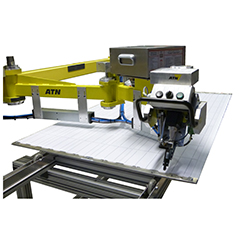X-Bus automatic induction soldering of interconnection of solar modules
In past years, induction soldering for interconnection of PV-modules has been established. This allowed soldering specialists ATN Automatisierungstechnik Niemeier GmbH from Berlin, Germany to install more than 300 soldering systems across the globe in the last three years. Up to now, most induction soldering systems have been integrated into fully automated systems. ATN now offers a semi-automated solution for smaller and more flexible manufacturing lines. The cross connectors are pre-assembled and then placed manually by using templates. Whereas the soldering process is automated and thus results in the quality expected of ATN.
In order to achieve the required contact between the ribbons for soldering, they are mechanically compressed and soldered under pressure. For this purpose, a ceramic hold-down with incorporated induction coil has been designed by ATN.
The pre-tinning of the busbars melts and forms the solder joint. Once the solder has solidified thesoldering stamp is lifted and positioned on the next solder joint. Optimized temperature profiles minimize cycle times.
X-BUS machine exists in 3 basic versions for different manufacturing line concepts.
X-BUS-Lx: Panel-Transfer LongEdgeLeading
X-BUS-Sx: Panel-Transfer ShortEdgeLeading
X-BUS-Tx: Machine with integrated rotation table
With the machines for “long edge leading”, X-BUS Lx, and the machines for “short edge leading”, X-BUS Sx, the templates with cross connectors are applied before the station and removed after the station. The cycle time is fully utilized for processing. Two handling systems work in parallel on the two sides of the module. A vision system measures the soldering positions to compensate for tolerances in the template position. The induction soldering then is done with either single, double or triple soldering heads. Machines with two triple heads and fast transfer (30 m/min) are capable of a throughput of 90 modules/h (cycle time 40 s).
The version X-BUS Tx is equipped with a rotary table and a single handling with soldering heads. It is possible to place and remove the templates inside the station. The module is moved into the station. The operator places the template on it. The table is rotated and the cross-connectors are soldered on the opposite side of the operator. At the same time, the operator places the next template. The table is rotated again. The second side is soldered while the operator removes the first template. After another rotation, the second template is removed and the module is moved out ofthe station. Depending on the configuration of the rotary table, “long edge leading” (LEL), “short edge leading” (SEL) or mixed transfers are possible, for example LEL-input from LayUp and SEL-output to inspection.
ATN also offers the supplementing systems for the assembly of cross connectors. The cutting machine processes material from a reel and it cuts it to the programmed length. The semi-automatic bending apparatus makes bending the L-connectors for J-boxes easy and precise.



























